高考语法全套复习讲义
- 格式:ppt
- 大小:7.50 MB
- 文档页数:560
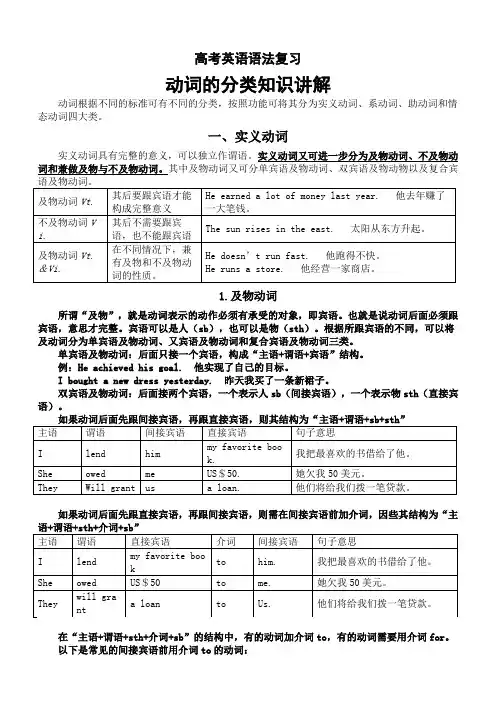
高考英语语法复习动词的分类知识讲解cry 哭泣disappear 消失go 走,趋于live 生存,居住rise 上升,增强shiver 颤抖,哆嗦sparkle 闪耀appear 出现decay 衰退exist 存在happen 发生occur 发生,出现roar 咆哮,喧闹sigh 叹息swim 游泳arise 出现,产生deteriorate 恶化fall 落下hesitate 犹豫scream 尖叫sit 坐,位于travel 旅行collapse 倒塌die 死亡flow 流动laugh 笑quiver 颤抖smile 微笑sneeze 打喷嚏lie 躺,位于,说谎age (使)成熟,变老break 打破(记录)close 关闭,结束decrease 减少,减小end 结束,终止grow 种植,生长meet 满足,对付;相遇shake 动摇,发抖spread 散布,铺开,传播stop 断绝,停止widen 加宽,变宽begin (使)开始burn 烧毁,燃烧continue (使)继续double (使)加倍finish 完成,终结improve 改善,加强open 打开,开始show 演示,说明;显示stand 忍受,抵抗;站立tear 撕毁,流泪stretch (使)伸展;使用,消耗boil (使)蒸发,沸腾change (使)改变cook 烹饪,做菜dry 弄干,变干fly 使飘扬,飞行increase 增加run 经营,运转slow 放慢,阻碍,变慢start 启动,出发turn 使旋转,转动。
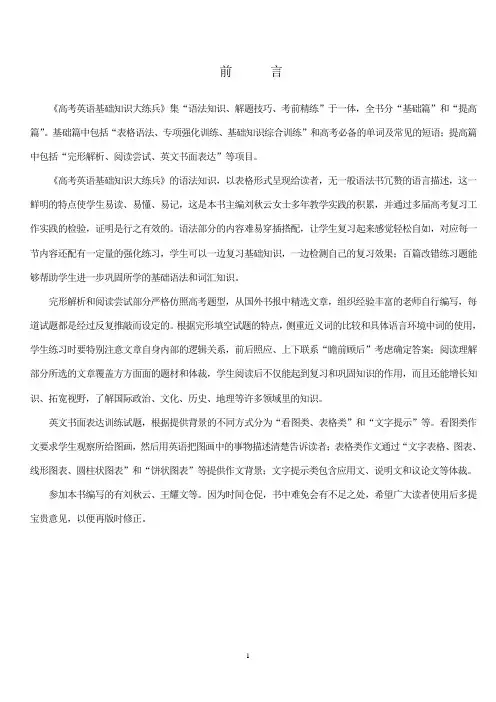
前言《高考英语基础知识大练兵》集“语法知识、解题技巧、考前精练”于一体,全书分“基础篇”和“提高篇”。
基础篇中包括“表格语法、专项强化训练、基础知识综合训练”和高考必备的单词及常见的短语;提高篇中包括“完形解析、阅读尝试、英文书面表达”等项目。
《高考英语基础知识大练兵》的语法知识,以表格形式呈现给读者,无一般语法书冗赘的语言描述,这一鲜明的特点使学生易读、易懂、易记,这是本书主编刘秋云女士多年教学实践的积累,并通过多届高考复习工作实践的检验,证明是行之有效的。
语法部分的内容难易穿插搭配,让学生复习起来感觉轻松自如,对应每一节内容还配有一定量的强化练习,学生可以一边复习基础知识,一边检测自己的复习效果;百篇改错练习题能够帮助学生进一步巩固所学的基础语法和词汇知识。
完形解析和阅读尝试部分严格仿照高考题型,从国外书报中精选文章,组织经验丰富的老师自行编写,每道试题都是经过反复推敲而设定的。
根据完形填空试题的特点,侧重近义词的比较和具体语言环境中词的使用,学生练习时要特别注意文章自身内部的逻辑关系,前后照应、上下联系“瞻前顾后”考虑确定答案;阅读理解部分所选的文章覆盖方方面面的题材和体裁,学生阅读后不仅能起到复习和巩固知识的作用,而且还能增长知识、拓宽视野,了解国际政治、文化、历史、地理等许多领域里的知识。
英文书面表达训练试题,根据提供背景的不同方式分为“看图类、表格类”和“文字提示”等。
看图类作文要求学生观察所给图画,然后用英语把图画中的事物描述清楚告诉读者;表格类作文通过“文字表格、图表、线形图表、圆柱状图表”和“饼状图表”等提供作文背景;文字提示类包含应用文、说明文和议论文等体裁。
参加本书编写的有刘秋云、王耀文等。
因为时间仓促,书中难免会有不足之处,希望广大读者使用后多提宝贵意见,以便再版时修正。
目录一、表格语法(一)名词数、格;数词……………………………………………..(二)冠词……………………………………………………………..(三)代词………………………………………………………………(四)形容词、副词及其比较等级…………………………………….(五)虚拟语气………………………………………………………..(六)非谓语动词……………………………………………………….(七)主谓一致………………………………………………………….(八)倒装句……………………………………………………………..(九)情态动词…………………………………………………………(十)动词的时态…………………………………………………………(十一)定语从句及引导词……………………………………………(十二)状语从句及引导词……………………………………………(十三)名词性从句及引导词………………………………………….(十四)反意疑问句及特殊情况的处理…………………………………二、强化训练试题(一)名词数、格以及数词练习………………………………………..(二)冠词练习…………………………………………………………..(三)代词练习……………………………………………………………(四)形容词、副词及其比较等级的练习………………………………..(五)虚拟语气练习………………………………………………………..(六)非谓语动词练习……………………………………………………..(七)主谓一致练习……………………………………………..(八)倒装句练习………………………………………………..(九)情态动词练习………………………………………………(十)动词时态的练习……………………………………………(十一)定语从句(同位语从句)练习………………………………(十二)状语从句练习……………………………………………(十三)名词性从句练习…………………………………………(十四)反意疑问句练习…………………………………………三、基础知识综合训练(一)连词综合训练………………………………………………(二)词与词组辨别……………………………………………….(三)短语动词与高考…………………………………………….(四)高考单项填空专项练习………………………………………(五)单句改错训练………………………………………………..(六)短文改错训练………………………………………………..一、Grammar Form 语法表格( 一) 名词的数、格数词1. n+s2. s,x,ch,sh,+es3. 元+y+s 辅+y+ies4. o + es5. f (fe)+ vesmap computer house horseclassesboxesbenchesbrushes但:stomachkey- toy-boy-destroy-spy-country-hero- tomato-potato- Negro-zero-但: radio- photo-piano- zoo---wi fe- li fe- leaf-shel f- kni fe-wol f- handkerchief-但:roof serf beliefchief gul f proof6.组合词-变主干7.全变8. 不变9.抽象名词(不+s,前不+a).但可用量词10. 名词所有格l ooker-on bus-driver book-shop bus-stop coffee cup paper tiger gold watch apple pie boy-student tooth-brush pencil-box grown-upgo-between brother-in-law son-in-law 但:man-doctor woman-doctor gentleman-farmermouse—ox—foot—tooth—man—woman---child---phenomenon-Englishman—Dutchman--但: German--sheep—sheepdeer—deerfi sh—fi shbellows—bellowsmeans—meanspeople—peopleChi nese—ChineseJapanese-- Japaneseadvi cenewsinformati onfunworkweatherhomeworkwoodhai rprogresssugaroil(用much )用a piece ofa suit of a cup ofa pair of a bag ofa set of a glass ofa bowl of a pile ofa bottle of人后+‘s; 物后不+‘sboy—boy‘s Mary and T om‘‘s roomboys—boy s‘ Mary‘s and T om‘‘s room sChar ler‘s book+ Char le s‘ bookAt the doc tor‘s/ at the ta ilor‘s但:the door of the rooma friend of mineTom‘s uncle‘s特殊名词:The poli ce +(be)The peopleThe public + are(i s)The familyThe class +are(i s)The teamThe cl othesThe trousers + (be)The glassesA si ut of clothes +(be)Two suits of +(be )A set of books + (be )区别:glass-----glassespaper-----papersgood-----goodsl ook-----l ooks数词1. 数词无复数2.数词+s +of3.连字符号+单名(无复数)fi ve hundred people ten thousand students two million citizenssi x dozen trees但: two dozen of the treesthousands ofmillions ofdozens ofscores oftwo-hundred peoplea fi ve-thousand-word arti clean ei ght-meter-wide walla fi ve-year-old boy但:He is fi ve years old.It i s a wall five meters wide.= It i s a fi ve-meter-wi de wall 5.a fewfewmanya good many +可数名词a great manymany a+名词单数+动词单数a great number of4. 分数/百分数/点数/加减乘除3 分子基(大于1)4 分母序(+ s )2 __1__3 42 1520 percent of 60 percent of8.562+3=5 (plus) 3-1=2 (minus) 3×5=15(times) 6÷3=2(divided by)6. an hour or two on May 1=on the f irst of May=one and two hours =on May the first7.每隔:every two hoursevery other dayevery second day8. 年代/分钟1999年3月5日20世纪90年代8点10分/7点差5分020-*******(电话) mucha littleli ttle +不可数名词a great deal ofa large amount of9. n+基数词Class 2 Gate 4 Room203 Page 2World War Two Road 23 Street 3 a lot ofplenty of +可(不可)名a large quantity of10.基数词+ n + edtwenty-storied buildingthree-legged table /five-col ored glass 11. a+序数词=又,再 a second(二)冠词a, an +the 不+the1.辅音音标前+a 1.彼此知道:或第二次提到;open ______ doorWhere i s _____ door? 1.专有名词I like X Science不可数名词X musi c抽象名词但__musi c of Mozard2.元音音标前+an 2.定修饰:_____ man i n redi n ___ winter of 1980 2.球类play X basketball棋类X chess三餐饭have X l unch但: have ___ni ce lunchWhat ____ good dinner!3.第一次提到或表示一个(一支,一本):aeg:-----Have you seen ____ pen?-----Is i t ____black one? 3.独一无二: ___sun, ___ earth___sky, ___moon但:in X space3.星期on x Sunday季节i n x wi nter月份on x February 12Day 节日on x Teachers‘ day但: In __w inter of 1998 / _____Spr ing Fe stiva l.4.类别:A bird….The bird…Birds…..____horses run faster than ___dogs ____deer i s bigger than a cat____elephant i s bigger than the dog 4.方位:方向. in ___southin __ north但: ___South Chi na___North Ameri caLie x south of China50 miles__ east of i t4.职位We elect hi m x monitor称呼x Father, get up !官位W e made him x PresidentFather and sonTeacher and student5.固定搭配have a coldhave a dri nkhave a resthave a classhave an i nterest ini n a hurryas a resul tonce a year 5.乐器play ____pianoplay ____violinplay ____gui tar5.泛指All persons are polite.学科I like x Chinese.Pl ease hel p x others.但:the Chi nese l anguagethe Japanese languageEnglish i s a knowl edge.6.+a 或an___one-legged man ___ ―f‖ letter ___universi ty___useful tool___umbrella ___uncle___European boy___ ―x ‖ letter . ___honest man __ei ght-year-old boy 6.序,形容词最高级the ninththe ninetieththe most necessary但: a second 又; 再a thi rd6. .固定搭配:go to the ci nemathe meetingthe theatreat table at the tablei n hospital i n the hospi tali n pri son in the pri sontake place take the place ofi n place of by mi stake7_____di fferent kind of ani mal s Give me ____coffee and __beer. ….same books of ____type.….as much ___art as……too hard _____job to….…so di ffi cult ____Engli sh book…What ____useful tool!What ____great surprise! 7.江河,海洋,山脉,湖泊,岛屿及含普通名词的专有名词.the Paci fi cthe Mountainthe Y ellow Ri verthe Great W allthe West Lakethe Tai Wang Isl and但:X Mount Taii n sight out of sightcatch sight of go to bedgo to college go to schoolafter school after classby the hour by handwith hand i n inkout of questi on i n bedi n public at sea i n the seaby the sea with one‘s hand 8.某一家人: The Turners are….某某家里: go to Turner‘sat x i nternational tradethe Engli sh l anguage9.the + 形=某一类人(动复)The ri ch _____ri ch.The wounded _____there.The Engli sh ____polite.The blind _____blind.1)___knowledge of Engli sh i s_____must at __i nternational trade.2)Kun Min i s _____ place with____warm winter and cool Summer(三)代词1.人称代词主格所有格宾格格物主代词反身代词1youyouheshetheywei t 2.两者eachei thernei therbotheg:On ____sides of the road are treesOn ____si de of the road are treesY ou can si t on ___side of the boatEach of you ___here. They each __(已来)Both of you ____hereEither of you ___hereNeither of you ____there3. 三者以上: allnoneno oneeveryeg: All ____present at the meeti ngAll ____goi ng on well____of you ___kind___has comeEvery thing ___okMany students are on___side of the street(each, every)____can take the books out(Every, Each) 4. one……. the othersome ……others(other+名词复数)other(泛指),the other(特指)another(又,再)不相同的另外一个(一组)eg: I have two pens, one i s red, ___i s black Some are singing, ___are paintingH ere are 60 boys, 20 boys are readi ng,what about _______?I don‘t like thi s pencil, please show me ___I have had one cup of tea, please give me __I‘ll re ad______(再读五本书)W e shoul d ready to help ______5 it 1.指人Who i s ____? It‘s me2.指天气_____i s fine3.形式宾语主语+V+ it +形+(for sb.)to do4.形式主语It +i s +----- + that5. 强调It i s +that (who )eg:I found it easy_______(to do, to do i t)I found it hard_______(背诵)It was not until 6 o‘clock ______he cameIt ______Engli sh and maths that I enjoyed(was, were) 6.some (something, someone)肯或请求对方肯定回答any(anything, anyone)否或条件状语从句肯定句中表示任何eg: W oul d you like ____tea?Will you please gi ve me ___advi ce?What about ____coffee?Have you ___ink?I have not ___money in my pocketI don‘t have ___idea of i tIf you have ___questions, please ask meY ou can come here at ___time7.疑问词+ever-----无论(主语或宾语)=no matter +疑(状语)whi chever = whatever =wherever = whenever =whoever = however +形=______goes home first should wash bowl s(Who, Whoever)______you come here should tell me(When ,Whenever)I don‘t believe _____y ou said (whatever, that) ______ti red I am, I‘ll come on (However, How)8.oneonesthi s(these)that(those)what(who, whi ch, whose)I li ke thi s kind of bi ke, I'll buy ______The red pens are ni cer than the black _____The ai r in thi s ci ty i s cleaner than ___in Beijing ____pronunciation i s the best in your grade?(四) 形、.副.及其比较级和.最高级1连系动词+形feeltastesmell + goodlook terrible becomesoundgetI don‘t feel well(adj.)但: sellwrite + wellcutwashThe pen writes smoothly The fish sells wellThe knife cut sharply The cloth washes softly. 5.性+大+新+颜+本+nan fine old stone walla nice big new redGerman doga fine little boythe last two sunny daysa nice red wooden box(一个美丽的印度黄色大木船)10. the + 比….the +比….越…. 就越______(越努力) you study,______(越多) progress youwill make.______(越粗心) you are,______(越少)marks you willget in the examination.15. than + that(代)单+ those(代)复The climate here isbetter than __in DalianThe students here areolder than _______inClass 219.变化规则1)单音节+er (est)redderthinnerbiggerwiserstrongerhotter2)双音节narrowableclever +er (est)earlyhappyheavyhungry但其余双音节或ly副词friendlyquicklyslowly +more(most)clearlybravelyhappilymodernactivetiredpatient16. less +形原+than= no +形比1) He is less friendly =He is no more friendly2) He is no taller than I=as short as I am.2.副词+形句子+副词不定代词+形形,副+enough 形+neg:wonderfully good terribly cold something good young enough terrible storm 6.so+adj+as to do如此---以至=形+enough +to doWould you be so kind asto help me?=W ould you be kind ____to help me?11.the+ 比+ of + the + two.He is___(clever) of the two.Of the two, he is____(active).He is __(modest)of the two.Which is___(large)country,China or Japan?17. most + 形= 很the most +形= 最a more +ing 形=更令人a + 比+ 名=更---的I‘ve never heard amore worrying voice.I‘ve never spent abetter day.3)多音节+morethe mostinterestingnecessarydifferentdeterminedimportantimpossible3.so +形/副+that such +形+抽名+that such +a+形+单+that =so +形+a+单名+that 但:manyso + much多/少+n+that fewlittleas +形+a+可名单+as too +形+a+可名单+to so +形+a+可名单+as 7.形+n+ ed= ad j数a middle-aged mana cold-blooded snakean eight legged deska three- storeyed laba kind-hearted man但:a good-looking man12.many more +可名+thanmuch more +不可名+thanHe eats ______ rice than I.He made ___mistakes than I.She has _____difficultiesthan Tom.18.This is the best filmthat IA. have never seenB. have ever seenC. had ever seenD. had never seenThis was the best meatthat IA. had never eatenB. had ever eatenC. have never eatenD. have ever eaten4)不规则变化good better bestmany more mostmuch more mostill worse worstbad worse worstbadly worse worstold older oldestold elder eldestfar farther farthestfar further furthest4.What +形+抽名/复名! What +a+形+可名单! =How +形+a+可名单! How +形+主语+…..!+副+主语+…..!+ 句子………! 8.as +形原+as肯/否so +形/原+as否He doesn't sing ____ we ll as I.As far as I know, he is old.据我所知He went as far as thestation.一直到----13.倍+as---as倍+形比+than倍+the sizethe leng th + ofthe heightThis tree is ____(比那棵高五倍)=__________=__________19.muchanystill +形比a lot (更--)farevena great deala littleeg:____pretty girls they are! What ____fine weather! What____ good advice! What ____nice girl!= ___nice a girl!____we love music!____nice it is!____fast he drives!!____fun it is! 9.比+比=越来越colder and colderredder and redder____________difficult___________ modern14.than +any other+名单(范内)than +any+名单(范外)China is larger than______country in A sia.China is larger than ______country in A frica.Jack is cleverer than _____(其他学生) in his classmore +形原1) He is than I.A. much tallB. much tallerC. more tallerD. more tall2)It is than that one.A. much interestingB. much moreinterestingC. most interesting(五)虚拟语气1.If从句did woul d现:i f + (were)…, 主句+should + domightcouldwould过:i f + had done…, 主句+should + have donemightshoulddid woul d将:i f + were to do, 主句+should + doshould do mightcoul d可省If用倒装句Were I you = If I were you, I would ____(学好英语)Had I known you = If I had known you, I would ____(帮你) Were I to go = If I were to go tomorrow, I woul d ___(打电话) Shoul d he come = If he should come soon, I would__(告诉你) If you shoul d go tomorrow, I would _______(来送你).(此项语法近几年大纲规定不考, 但要了解) 2. it i s … + adj ……+ v….. that +…..…+ n…..It i s necessaryi mportant that….. + (should) dostrangeordercommandsuggest(suggesti on)advi se(advi ce)propose(proposal) that…. + (shoul d) dodemandrequi redesirerequesti nsi st(坚决要求)They suggested that he ______(send) to Bri tain. He ordered that she _______(operate)on at once. 但: suggest, insi st表暗示, 坚持认为:不+虚拟语气The dark cl oud suggested that it ______( rain).He i nsi sted that he _______(never see ) a tiger.He i nsi sted that he _____( be )not ill.3. wi sh 指现在----改为过去时as i f 指过去(或完成)----改为过去完成时i f onl y 指将来----改为过去将来时I wi sh I ______(know)Engli sh.I wi sh I ______(have) much moneyI wi sh I ______( be )born in the big ci ty in 1989I wi sh he _____(know) each other for two years. He looks as if he _____(know)much Engli sh.He looks as if he _____(come)here last night.He looks as if he _____(leave)tomorrow.If only I _____(know)hi m!If only I _____(去过)to Ameri ca! 4. It i s (high) time that + di d ……= It i s time for sb. to doIt i s time that we _____( have )our lunchIt i s high time we _______( hold )the sports meetIt i s about ti me that we ________( fini sh ) our lessons. It i s time he ______(clean)the blackboard.5. 本能could have done本可以mi ght have done本该should have done = ought to have done本不必要needn't have done本希望had hoped本想had thought本愿意would like to have done但: can't have done 表“过去曾经一定没有”(推测)must have done 表“过去曾经一定”(推测)Y ou are late, you ________(本该来) earlier.Y ou're too lazy, you _______(本能回答) it.There're much ti me left, you _______(本不必要着急)I______(本该完成) my work last night, but I saw a film. Y ou______(本可以帮助) hi m, even if you were busy.I_____(本希望) I woul d come, but I was too busy.He was here just now, he_______(一定没去) Beijing. (此项语法项目是近几年的高考热门题) 6.but 前虚拟,but后不虚拟。
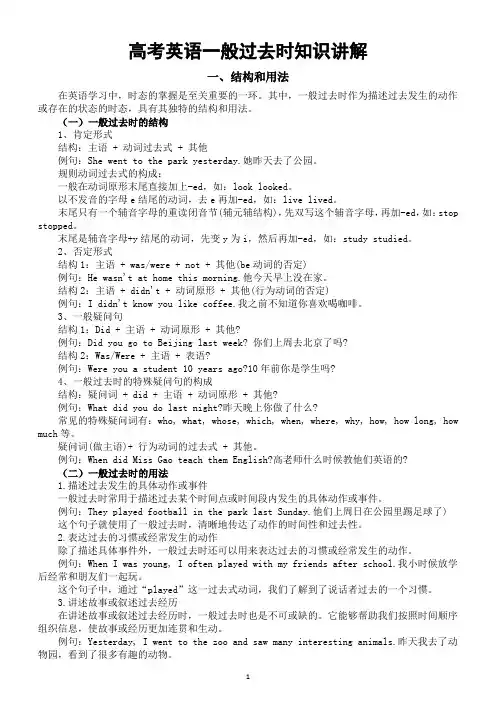
高考英语一般过去时知识讲解一、结构和用法在英语学习中,时态的掌握是至关重要的一环。
其中,一般过去时作为描述过去发生的动作或存在的状态的时态,具有其独特的结构和用法。
(一)一般过去时的结构1、肯定形式结构:主语 + 动词过去式 + 其他例句:She went to the park yesterday.她昨天去了公园。
规则动词过去式的构成:一般在动词原形末尾直接加上-ed,如:look looked。
以不发音的字母e结尾的动词,去e再加-ed,如:live lived。
末尾只有一个辅音字母的重读闭音节(辅元辅结构),先双写这个辅音字母,再加-ed,如:stop stopped。
末尾是辅音字母+y结尾的动词,先变y为i,然后再加-ed,如:study studied。
2、否定形式结构1:主语 + was/were + not + 其他(be动词的否定)例句:He wasn't at home this morning.他今天早上没在家。
结构2:主语 + didn't + 动词原形 + 其他(行为动词的否定)例句:I didn't know you like coffee.我之前不知道你喜欢喝咖啡。
3、一般疑问句结构1:Did + 主语 + 动词原形 + 其他?例句:Did you go to Beijing last week? 你们上周去北京了吗?结构2:Was/Were + 主语 + 表语?例句:Were you a student 10 years ago?10年前你是学生吗?4、一般过去时的特殊疑问句的构成结构:疑问词 + did + 主语 + 动词原形 + 其他?例句:What did you do last night?昨天晚上你做了什么?常见的特殊疑问词有:who, what, whose, which, when, where, why, how, how long, how much等。
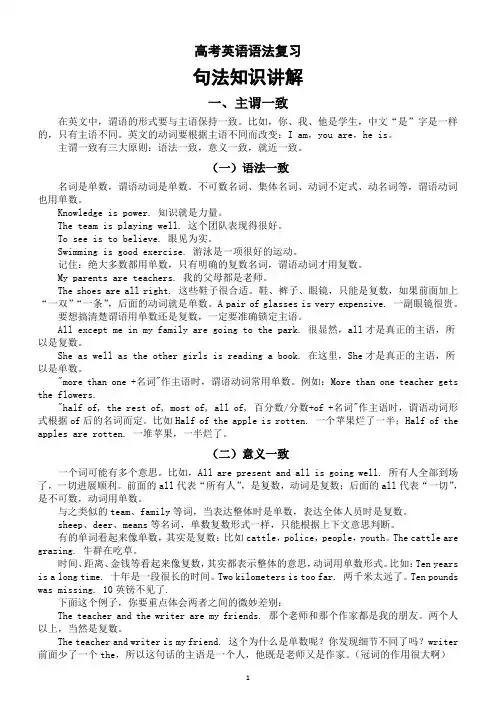
高考英语语法复习句法知识讲解一、主谓一致在英文中,谓语的形式要与主语保持一致。
比如,你、我、他是学生,中文“是”字是一样的,只有主语不同。
英文的动词要根据主语不同而改变:I am,you are,he is。
主谓一致有三大原则:语法一致,意义一致,就近一致。
(一)语法一致名词是单数,谓语动词是单数。
不可数名词、集体名词、动词不定式、动名词等,谓语动词也用单数。
Knowledge is power. 知识就是力量。
The team is playing well. 这个团队表现得很好。
To see is to believe. 眼见为实。
Swimming is good exercise. 游泳是一项很好的运动。
记住:绝大多数都用单数,只有明确的复数名词,谓语动词才用复数。
My parents are teachers. 我的父母都是老师。
The shoes are all right. 这些鞋子很合适。
鞋、裤子、眼镜,只能是复数,如果前面加上“一双”“一条”,后面的动词就是单数。
A pair of glasses is very expensive. 一副眼镜很贵。
要想搞清楚谓语用单数还是复数,一定要准确锁定主语。
All except me in my family are going to the park. 很显然,all才是真正的主语,所以是复数。
She as well as the other girls is reading a book. 在这里,She才是真正的主语,所以是单数。
"more than one +名词"作主语时,谓语动词常用单数。
例如:More than one teacher gets the flowers."half of, the rest of, most of, all of, 百分数/分数+of +名词"作主语时,谓语动词形式根据of后的名词而定。

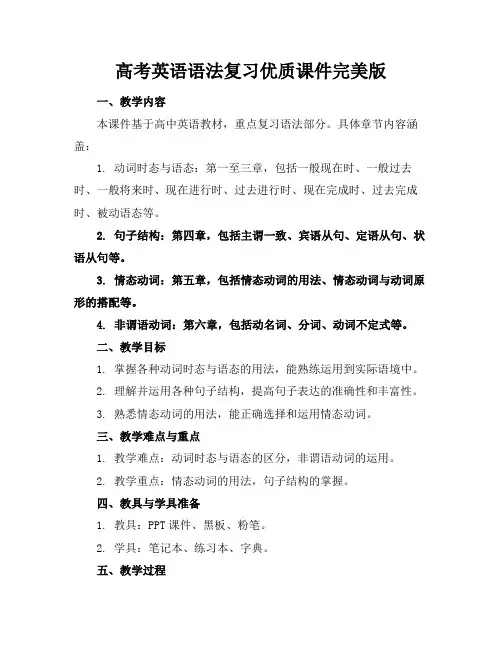
高考英语语法复习优质课件完美版一、教学内容本课件基于高中英语教材,重点复习语法部分。
具体章节内容涵盖:1. 动词时态与语态:第一至三章,包括一般现在时、一般过去时、一般将来时、现在进行时、过去进行时、现在完成时、过去完成时、被动语态等。
2. 句子结构:第四章,包括主谓一致、宾语从句、定语从句、状语从句等。
3. 情态动词:第五章,包括情态动词的用法、情态动词与动词原形的搭配等。
4. 非谓语动词:第六章,包括动名词、分词、动词不定式等。
二、教学目标1. 掌握各种动词时态与语态的用法,能熟练运用到实际语境中。
2. 理解并运用各种句子结构,提高句子表达的准确性和丰富性。
3. 熟悉情态动词的用法,能正确选择和运用情态动词。
三、教学难点与重点1. 教学难点:动词时态与语态的区分,非谓语动词的运用。
2. 教学重点:情态动词的用法,句子结构的掌握。
四、教具与学具准备1. 教具:PPT课件、黑板、粉笔。
2. 学具:笔记本、练习本、字典。
五、教学过程1. 导入:通过一个实践情景,引导学生复习动词时态与语态。
2. 课件展示:讲解动词时态与语态的用法,结合例题进行分析。
3. 随堂练习:让学生完成动词时态与语态的练习题,巩固所学知识。
4. 课件展示:讲解句子结构,结合例题进行分析。
5. 随堂练习:让学生完成句子结构的练习题,提高句子表达的准确性。
6. 课件展示:讲解情态动词的用法,结合例题进行分析。
7. 随堂练习:让学生完成情态动词的练习题,熟悉情态动词的用法。
六、板书设计1. 动词时态与语态:用表格形式展示各种时态与语态的用法。
2. 句子结构:用流程图展示各种句子结构。
3. 情态动词:用表格形式展示情态动词的用法。
七、作业设计1. 作业题目:2. 答案:见附录。
八、课后反思及拓展延伸2. 拓展延伸:鼓励学生在课后阅读英语文章,积累更多语法知识,提高英语水平。
重点和难点解析1. 教学内容的针对性:动词时态与语态、句子结构、情态动词、非谓语动词的选择与讲解。
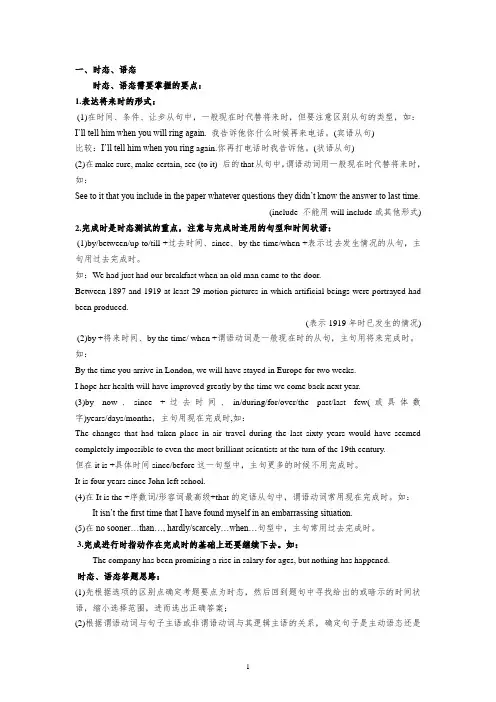
一、时态、语态时态、语态需要掌握的要点:1.表达将来时的形式:(1)在时间、条件、让步从句中,一般现在时代替将来时,但要注意区别从句的类型,如:I’ll tell him when you will ring again. 我告诉他你什么时候再来电话。
(宾语从句)比较:I’ll tell him when you ring again.你再打电话时我告诉他。
(状语从句)(2)在make sure, make certain, see (to it) 后的that从句中,谓语动词用一般现在时代替将来时,如:See to it that you include in the paper whatever questions they didn’t know the answer to last time.(include 不能用will include或其他形式) 2.完成时是时态测试的重点,注意与完成时连用的句型和时间状语:(1)by/between/up to/till +过去时间、since、by the time/when +表示过去发生情况的从句,主句用过去完成时。
如:We had just had our breakfast when an old man came to the door.Between 1897 and 1919 at least 29 motion pictures in which artificial beings were portrayed had been produced.(表示1919年时已发生的情况) (2)by +将来时间、by the time/ when +谓语动词是一般现在时的从句,主句用将来完成时。
如:By the time you arrive in London, we will have stayed in Europe for two weeks.I hope her health will have improved greatly by the time we come back next year.(3)by now、since +过去时间、in/during/for/over/the past/last few(或具体数字)years/days/months,主句用现在完成时,如:The changes that had taken place in air travel during the last sixty years would have seemed completely impossible to even the most brilliant scientists at the turn of the 19th century.但在it is +具体时间since/before这一句型中,主句更多的时候不用完成时。

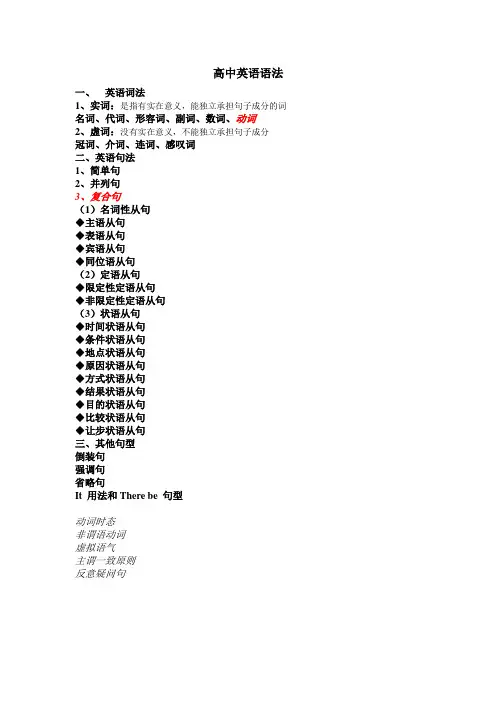
高中英语语法一、英语词法1、实词:是指有实在意义,能独立承担句子成分的词名词、代词、形容词、副词、数词、动词2、虚词:没有实在意义,不能独立承担句子成分冠词、介词、连词、感叹词二、英语句法1、简单句2、并列句3、复合句(1)名词性从句◆主语从句◆表语从句◆宾语从句◆同位语从句(2)定语从句◆限定性定语从句◆非限定性定语从句(3)状语从句◆时间状语从句◆条件状语从句◆地点状语从句◆原因状语从句◆方式状语从句◆结果状语从句◆目的状语从句◆比较状语从句◆让步状语从句三、其他句型倒装句强调句省略句It 用法和There be 句型动词时态非谓语动词虚拟语气主谓一致原则反意疑问句第一讲:句子类型与句子成分一、句子种类和类型1、句子种类陈述句;疑问句;祈使句;感叹句2、句子类型简单句:由一个主语加一个谓语构成.并列句:两个或两个以上的简单句用并列连词连在一起构成的句子,叫做并列句,其基本结构是“简单句+并列连词+简单句”。
并列连词有:and, but, or, so, either…or.. neither...nor.. however not only…but also 等.并列句中的各简单句意义同等重要,相互之间没有从属关系,是平行并列的关系。
Hurry up or you'll be late.He is rich while I’m poor.复合句: 由主句和其他从句组成。
并列复合句:含有复合句的并列句.★I asked a man who has a wife and three children who did the cooking in his house and he replied that whoever came home from work first did it.二、句子成分That girl is doing her homework now.主语:主语是句子陈述的对象,说明是谁或什么情况。
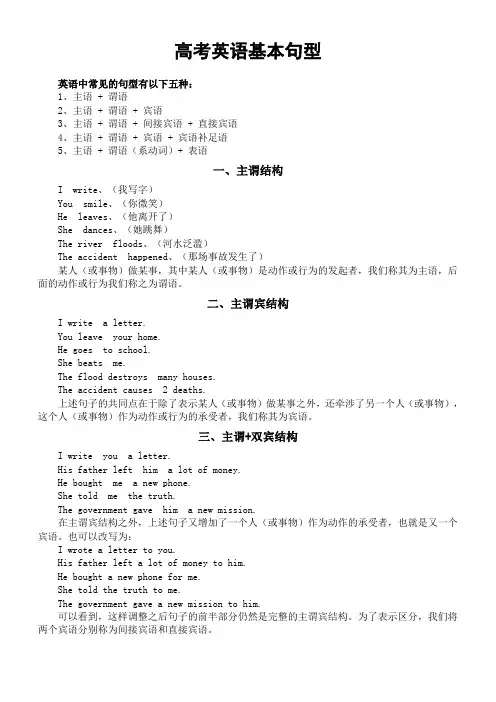
高考英语基本句型英语中常见的句型有以下五种:1、主语 + 谓语2、主语 + 谓语 + 宾语3、主语 + 谓语 + 间接宾语 + 直接宾语4、主语 + 谓语 + 宾语 + 宾语补足语5、主语 + 谓语(系动词)+ 表语一、主谓结构I write、(我写字)You smile、(你微笑)He leaves、(他离开了)She dances、(她跳舞)The river floods、(河水泛滥)The accident happened、(那场事故发生了)某人(或事物)做某事,其中某人(或事物)是动作或行为的发起者,我们称其为主语,后面的动作或行为我们称之为谓语。
二、主谓宾结构I write a letter.You leave your home.He goes to school.She beats me.The flood destroys many houses.The accident causes 2 deaths.上述句子的共同点在于除了表示某人(或事物)做某事之外,还牵涉了另一个人(或事物),这个人(或事物)作为动作或行为的承受者,我们称其为宾语。
三、主谓+双宾结构I write you a letter.His father left him a lot of money.He bought me a new phone.She told me the truth.The government gave him a new mission.在主谓宾结构之外,上述句子又增加了一个人(或事物)作为动作的承受者,也就是又一个宾语。
也可以改写为:I wrote a letter to you.His father left a lot of money to him.He bought a new phone for me.She told the truth to me.The government gave a new mission to him.可以看到,这样调整之后句子的前半部分仍然是完整的主谓宾结构。
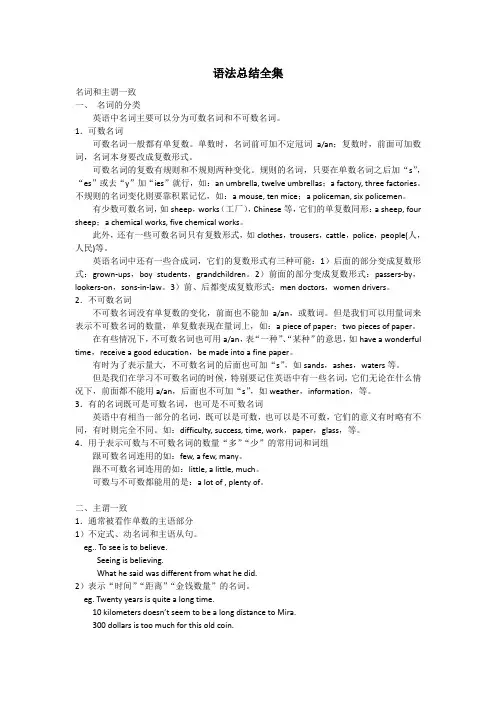
语法总结全集名词和主谓一致一、名词的分类英语中名词主要可以分为可数名词和不可数名词。
1.可数名词可数名词一般都有单复数。
单数时,名词前可加不定冠词a/an;复数时,前面可加数词,名词本身要改成复数形式。
可数名词的复数有规则和不规则两种变化。
规则的名词,只要在单数名词之后加“s”,“es”或去“y”加“ies”就行,如:an umbrella, twelve umbrellas;a factory, three factories。
不规则的名词变化则要靠积累记忆,如:a mouse, ten mice;a policeman, six policemen。
有少数可数名词,如sheep,works(工厂),Chinese等,它们的单复数同形:a sheep, four sheep;a chemical works, five chemical works。
此外,还有一些可数名词只有复数形式,如clothes,trousers,cattle,police,people(人,人民)等。
英语名词中还有一些合成词,它们的复数形式有三种可能:1)后面的部分变成复数形式:grown-ups,boy students,grandchildren。
2)前面的部分变成复数形式:passers-by,lookers-on,sons-in-law。
3)前、后都变成复数形式:men doctors,women drivers。
2.不可数名词不可数名词没有单复数的变化,前面也不能加a/an,或数词。
但是我们可以用量词来表示不可数名词的数量,单复数表现在量词上,如:a piece of paper;two pieces of paper。
在有些情况下,不可数名词也可用a/an,表“一种”、“某种”的意思,如have a wonderful time,receive a good education,be made into a fine paper。
高考语法讲义一.非谓语动词一.不定式:一)不定式的常考形式:1)一般形式:He decided to work harder in order to catch up with the others.被动形式: He preferred to be assigned some heavier work to do.语法功能:表示与谓语动词同步发生2)完成形式:He pretended not to have seen me.被动形式:The book is said to have been translated into many languages.语法功能:表示发生在谓语动词之前二)不定式常考的考点:1)不定式做定语----将要发生2)不定式做状语----目的3)不定式充当名词功能---To see is to believe.三)不定式的省略1)感官动词see, watch, observe, notice, look at, hear, listen to, smell, taste, feel+ do表示动作的完整性,真实性;+ doing表示动作的连续性,进行性I saw him work in the garden yesterday.昨天我看见他在花园里干活了。
(强调"我看见了"这个事实)I saw him working in the garden yesterday.昨天我见他正在花园里干活。
(强调"我见他正干活"这个动作)感官动词后面接形容词而不是副词:The cake tastes good; It feels comfortable.2) 使役动词have bid make let 等词后不定式要省略但同1)一样被动以后要还原toI ‘d like to have John do it.I have my package weighed.Paul doesn’t have to be made to learn.3) help help sb do help sb to do help do help to do四)有些动词后只跟不定式如:want,wish,hope,manage,promise,refuse,pretend,plan,offer,decide,agree,expect allow sb to do, cause sb to do , permit sb to do, enable sb to doforce sb to do. be more likely to do love to do warn sb to do be able to dobe ambitious to do. begin to do . start to doWe agreed _______ here,but so far she hasn't turned up yet.(NMET 1995)A.having met B.meeting C.to meet D.to have met (Key:C)五) 有的时候to后面要接-ing形式accustom (oneself) to; be accustomed to; face up to; in addition to; look forward to; object to; be reduced to; resign oneself to; be resigned to; resort to; sink to; be used to; be alternative to; be close/closeness to; be dedication/dedicated to; be opposition/opposed to; be similarity/similar to.三、need/want 后的-ing形式具有被动的意思。
高考英语语法复习虚拟语气知识讲解一、基础知识(一)什么是虚拟语气谓语动词的作用不仅可以表示动作的时间、状态、假设(情感),也是一种语气(mood)的表现形式,表明说话的目的和意图。
(语气包含陈述语气、祈使语气、虚拟语气、疑问语气)虚拟语气用于表示假设、愿望、建议、命令等非真实或虚拟的情况,即与真实相反。
上学的时候老师经常举的一个例子,"If I were you"因为我不可能是你,这是一种不可能存在的事实,所以这是个虚拟语句。
总而言之英语中的虚拟语气可以分为两大体系:一是表示与事实相反的,或者是假象的情形,通常由if引导,叫做虚拟条件句;另一个体系是在名词从句中使用虚拟语气,表示建议,命令或者要求等语气,类似于上述美剧常用的台词。
(二)虚拟语气的用法这一部分我们主要用虚拟语气在条件句中的用法作为讲解不同情况条件从句谓语主句谓语使用场景与过去事实相反If+主语+haddone主语+should/would/could/might+have done既然是过去了,那么谈到的一切情况都已既成事实,所以过去虚拟表达的是一个与过去事实相反的情形与现在事实相反If+主语+did(be动词用were)主语+should/would/could/might+do既可能是事实,也可能是假设条件。
因此,假设条件句和事实相反句适用于谈现在的情况与将来事实相反If+主语+ did(be动词用were)If+主语+ wereto + doIf+主语+should+ do主语+should/would/could/might+do对于将来时间的虚拟不可能以事实为基础,而只能是表达说话人的一个设想或愿望。
所以,对于将来的虚拟只适用于假设条件句,而不可能表达一个与事实相反的虚拟与现在事实相反:If I had a map, I would lend it to you.如果我有地图我就借给你。
(但我没有)与将来事实相反:If I were to do the job, I would do it in a different way. 要是我来做这工作,我会是另一种做法。
现代汉语语法知识讲义--语素(高三年级复习)现代汉语语法知识讲义(高三年级复习用)第一节概说现代汉语语法基本知识,包括语素、词语、短语、句子、句群等五个方面。
语素是汉语中最小的语义单位,也是汉语的一级语言单位(语法理论书上表述为“最小的语音语义结合体”,实际上它只是最小语义单位)。
虽说这个语法单位是语法家们研究的范畴,但是学好它对于我们把握词语的构成、辨析近义词和同义词也有很大的帮助作用。
词语是汉语的二级语言单位,它是我们语文学习的基本核心,掌握大量的词语是写作的基础,也是我们做好高考复习工作的重要组成部分。
词语知识包括词类、词的结构(熟语,主要是成语)、近义词(同义词)辨析这三个主要主要方面(这里只从高考的角度球入,实际上还包括“词语的选用”“反义词”“成语”等)。
短语是汉语的三级语言单位,对于短语结构的熟练把握,有助于我们分析语言结构,从而使我们能够更好地理解语言的意义。
短语知识主要包括短语的类型、短语的结构和熟语(主要是“成语”)三个方面。
句子是汉语的四级语言单位,这是高考必考的内容,而且是难点、重点。
句子知识主要包括句子的分类、句子的结构以及句式的变换、选用和仿用三个方面。
句群是汉语的五级语言单位,这个语言单位与语段的层次结构非常相似,只需要了解一下即可。
附:汉语语法知识结构图语素的概念语素语素的种类(单音节、多音节/自由、半自由、不自由)语素与汉字的关系(一字一素/一字多素/多字一素)词语的概念词语的种类(实词、虚词)词语词语的结构(并偏支补陈加叠,外加名量很特别)词语的意义(同义词、近义词、熟语、成语)词语的色彩(褒义词、中性词、贬义词)短语的概念短语短语的语法种类短语的结构种类(成语)句子的概念句子句子的种类(用途和语气、结构、骈散等来划分)句子的结构(单句、复句)句式的变换、选用和仿用※语病的辨析与修改※句群(句子之间的各种逻辑关系)[歌诀] 五级语言单位,意义结构切分。
语素、词语、短语,还有句子、句群。
高三重点语法总结复习1.the same...that... 和...一样We don’t have the samework hours that office workers in the city office have.2.so+adj/adv+that; such+n+that;如此...以至于〔结果状从〕The newlybuilt stadium is so big that it can hold all the teachers and students in our school.倒装变式;So big is the newlybuilt stadium that it can hold all the teachers and students.3.so that以便...,目的是...〔缘由状从〕I read more books so that I can catch up with my classmates.4.be doing ...when正在做某事...突然She was walking along the bank of the river when she heard a cry for help.5.with/make /leave+宾语+宾补With the current world conditions forcing us to stay longer indoors,you’ve likely tried to pick up a new skill.We should take effective measures to ptotect our planet,making it a more beautiful place.6.when/while/if/as+adj/非谓语〔状语从句的省略:当从句的主语和主句的主语全都或从句的主语为it时,且从句的谓语动词含有be动词时,可以把从句中的主语和be动词一起省去〕While+doing; if possible/necessary; as planned/shecduled/arrangedTwo years later.the worker was caught in Italy when trying to selling the painting.7.祈使句+and+陈述句;表示承接8 祈使句+or+陈述句;表示转折Give me a challenge,and I’ll meet it with joy.Please e here,and you will interested in papercuting.8.It is said that=Sb/Sth is said to do 〔据说句型,从句和不定式的相互转化〕On this day,the moon is said to be its biggest and brightest.On this day,it is said that the moon is biggest and brightest.9.be+adj+to dois easy to do;is hard to doAlthough the work was not easy to do,we felt happy and satisfied.10.表示方位的介词短语或表示时间,地点,方位的副词放于句首时,句子要半倒装常见的有:among;then ;inUnder the big tree was sitting an old farmer.11.常见的主语从句的四种类型:It is +adj+thatIt is +过去分词+thatIt is +名词短语+thatIt is +不及物动词〔happen,occur,appear,seem...〕+thatIt is clear that we are going to see a huge growth in shopping on the internet.12.I t+现在完成时+since+一般过去时;“自从...已经有多长时间了〞It has been two weeks since you went back home.13.n ot..until“知道...才〞Not until I received your last letter did I learn your keen interest in Chinese culture. 14.w hether...or“无论是...还是〞If he is out there every day and playing hard,you should praise his effort regardless of whether his team wins or loses.15.否认词+比拟级“表示最高级〞Nothing is more difficult than that.16.c an not/never/hardly be too +adjcan not/never/hardly be adj+enough “再...也不为过〞You can never be too careful when you cross the road.17.I t is/was...who/that...强调句.I know it is one of chinese traditional art formspapercutting that you are interested in.So I invite you to attend an exhibition of it.The more you know about papercutting,the better you will love it.18.t hat引导的同位语结构某些抽象名词后,如:fact,hope,idea,news,belief,sign等后,常跟that引导的同位语从句There is no doubt that you are supposed to know about the history of the Tang Dynasty in advance.There are no signs that Tom was a rich man.19.b e of +adj+n=be of +adjbe of great value=be valuable; be of great help=be helpfulbe of great significance=be significant; be of great benefit=be beneficialI do hope these suggestions above will be of some help to you.20.a s long as“只要;引导条件状语从句〞This proves that as long as we have a strong will ,we’ll be able to get over any difficulty.21.h ave a difficult 〔in〕doing sth“有一段困难的时间〞I had a difficult time 〔in〕adjusting to the learning environment when I first entered the new school.22.t he last time“上次〞引导时间状语从句,不和when连用I still remember you showed me some photos on that theme the last time you visited our school.23.t hat’s why“那就是为什么...〞that’s because“那是由于〞That’s why I think the trip along the Yangtze River will be a better choice.Form the space,the earth looks blue. This is because about sevenone percent of its surface is covered by water.24.T he reason why...is that...“...的缘由是...〞The reason why I show respect for her is that she never loss temper instead always encourage me.25.t he +比拟级,the+比拟级“越...越〞The more you give,the more you will get.〔付出越多,收获越多〕26.t he moment“一...就〞引导时间状语从句Generally speaking,we are busy reviewing and preparing for the College EntranceExamination the moment we enter senior three.27.n ot...but...“不是...而是〞V oters sometimes feel annoyed,not because they hate voting,but because they don’t like being forced to do so.28.I t’s high time that sb +一般过去时/should +动词原形“到了该做某事的时间了〞It/This/That is/was the+序数词time that sb+现在完成时/过去完成时某人第几次做某事It’s high time that we devoted /should devote ourselves to environmental protection and ecological improvement.It’s the second time that I have been to Shanghai.29.s o所引导的倒装句:so+be动词/助动词/情态动词+主语Tom likes to keep pets and so does his wife.〔汤姆喜爱养宠物,他妻子也一样〕30.g et+过去分词31.N o sooner +过去完成时+thanhardly+过去完成时+when“一...就〞No sooner had Mo Yan stepped on the stage than the audience broke into thunderous applause.32.m ake用法make sb do sth让某人做某事;sb be made to do sth被人被要求做某事make it +adjmake oneself doneThe boss made the worker do the work all day.The purpose of new technologies is to make life easier,not to make it more convinent. She managed to make herself understood in English.。
2024年高考英语语法复习课件完美版一、教学内容本课件依据《普通高中英语课程标准》和2024年高考英语考试大纲,围绕教材《英语》必修一到必修五的语法知识点进行复习。
详细内容包括:时态、语态、非谓语动词、名词性从句、定语从句、状语从句、倒装句、强调句等章节,结合高考真题,帮助学生全面掌握英语语法。
二、教学目标1. 熟练运用各种时态、语态,正确区分非谓语动词的用法。
2. 掌握名词性从句、定语从句、状语从句的引导词和基本结构,提高阅读理解能力。
3. 了解倒装句、强调句的构成和用法,提升写作水平。
三、教学难点与重点1. 教学难点:非谓语动词、名词性从句、定语从句、倒装句、强调句的用法。
2. 教学重点:时态、语态的正确运用,各类从句的引导词和结构,以及倒装句、强调句的构成。
四、教具与学具准备1. 教具:多媒体教学设备、PPT课件、黑板、粉笔。
2. 学具:教材、《英语语法指南》、笔记本、练习本。
五、教学过程1. 导入:通过展示一段关于时间变化的视频,引导学生回顾时态、语态的知识点。
2. 讲解:结合PPT课件,详细讲解各类语法的用法,穿插例题讲解和随堂练习。
3. 练习:分组讨论,让学生互相出题,检验学习效果。
5. 作业布置:布置课后作业,要求学生按时完成。
六、板书设计1. 时态、语态表格2. 名词性从句、定语从句、状语从句结构图3. 倒装句、强调句构成示例七、作业设计1. 作业题目:(1)完成《英语》必修一到必修五的语法练习题;(2)根据所给句子,改写为倒装句、强调句;(3)用非谓语动词改写下列句子。
2. 答案:(1)见教材课后练习;(2)见教材课后练习;(3)见教材课后练习。
八、课后反思及拓展延伸1. 反思:关注学生的学习情况,了解他们在语法学习中的困难,及时调整教学方法。
2. 拓展延伸:推荐学生阅读英语语法书籍,提高语法水平,为高考英语复习奠定基础。
同时,鼓励学生参加英语角、英语演讲比赛等活动,提升英语实际应用能力。